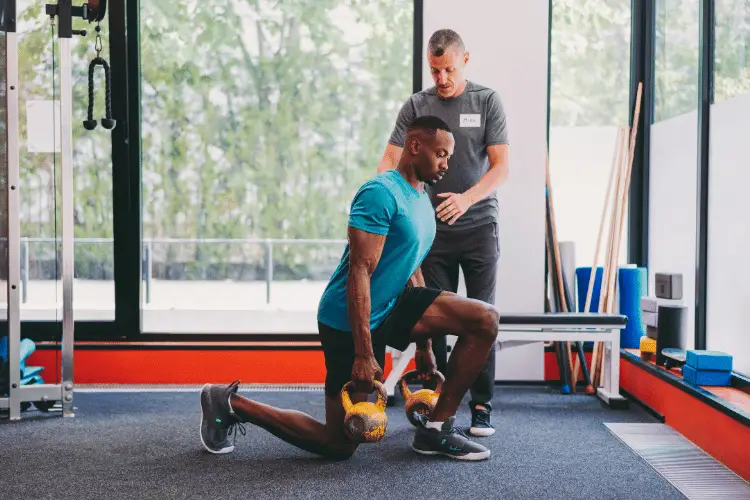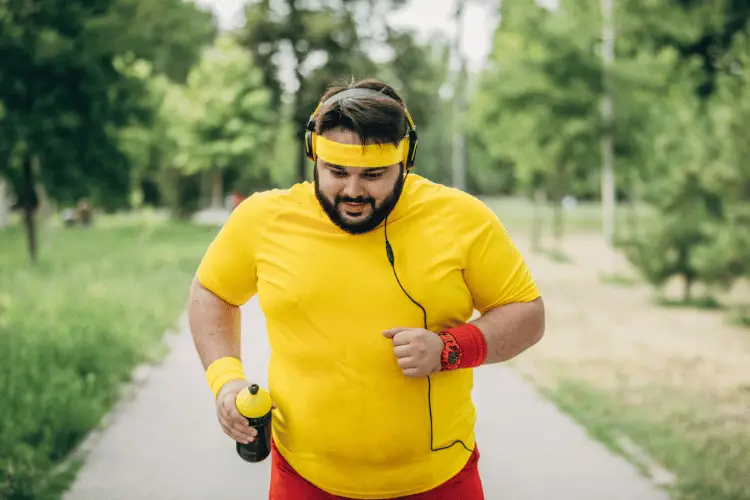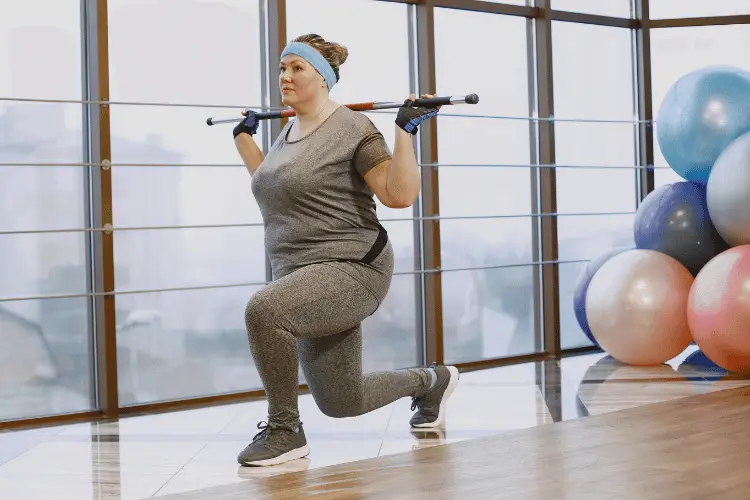Lots of people start working out and stick to a healthy diet for the sole purpose of sculpting and toning specific areas of their body.
For example, women often want to remove extra fat in their thighs, upper arms, or hips. Men usually target belly fat to look leaner.
Targeting fat in certain areas of the body is known as spot reduction. This is where people focus on specific muscles to slim down these areas. The question is, does it work? Do inner and outer thigh machines burn thigh fat?
The short answer is no.
What’s Spot Reduction?
Spot reduction was a popular approach in the fitness world as people (naturally) thought they could target fat loss in specific areas of their bodies.
Unfortunately, spot reduction is a debunked myth.
Many studies have demonstrated that it isn’t possible to target fat loss to specific body parts. For instance, one study tracked belly fat loss in people who completed only abdominal exercises for six weeks. The results showed no belly fat reduction.
Another study focused on the effectiveness of upper body resistance training showed similar results.
I remember reading a study in college where the participants trained only one leg. If spot training worked, they would end up with one leg skinnier than the other. Didn’t happen.
Despite all the studies showing that spot reduction is ineffective, some studies proved otherwise. One study including 16 women, showed that localized training followed by half an hour of cycling resulted in fat loss in specific areas.
A similar study conducted on 10 people found that fat loss was higher in areas close to contracting muscles.
However, researchers found that even if fat loss occurs, it’s usually generalized to the whole body, not targeted areas. That’s because of how fat loss occurs.
How Does Fat Loss Occur?
To understand why spot reduction isn’t possible, you need to know how fat loss works.
Fat loss occurs when your body uses stored fat as fuel. This happens when you consume fewer calories than you burn, which creates a calorie deficit.
In a calorie deficit, your body consumes stored fat to get energy. As such, the cells used for energy decrease in size, resulting in weight loss.

Here comes the problem:
Your body doesn’t use fat from the areas you’re working. In other words, using inner or outer thigh machines won’t remove fat specifically and only from your thighs.
Benefits of Spot Training
Now that you understand that spot reduction is a myth, you might wonder why people still use these hyper-specialized machines at the gym, even if they’re not losing fat in a target area.
But spot training can benefit muscles, not fat.
In other words, you can target specific areas of your body to increase muscle tone, definition, and strength. While doing so, you’ll lose fat throughout your body.
One study found that participants who had 12 weeks of localized muscle resistance training three times a week lost around 1.5 pounds of total body fat.
Furthermore, spot training is handy if you have imbalanced or weak muscles. For instance, some sports and activities require specific muscles to be strong and well-developed.
Focusing on these muscles through spot training can improve your performance and decrease your injury risk as well.
Alternatives to Spot Training
While spot training isn’t the most effective approach to weight loss, studies show that there are better approaches to shedding pounds.
- High-Intensity Interval Training (HIIT)
HIIT is a type of cardiovascular exercise that alternates between short periods of intense aerobic exercise and a brief recovery period.
The main goal of a HIIT workout is to push your body to its maximum limits during high-intensity intervals when your muscles are oxygen deprived.
Research shows that HIIT might be more effective in burning fat than steady-state cardio. Here are the benefits of HIIT training:
- Increases fat oxidation
- Boosts post-exercise fat consumption
- Brings down your appetite by reducing the ghrelin hormone
- Regulates blood glucose levels
- Far more time efficient than cardio

- Cardiovascular Exercise
Also known as cardio or aerobic exercise, cardiovascular exercise focuses on increasing your heart and respiration rates.
It utilizes large muscle groups in your body, such as the legs and upper body. This requires more work from your heart and lungs to deliver oxygen to your muscles.
Cardiovascular exercise includes cycling, swimming, jogging, and fitness classes. In addition, you can use cardio machines such as treadmills, stair climbers, rowers, and bikes.
Burning calories and losing extra pounds with cardio is extremely efficient.
According to the U.S. Department of Health and Human Services, getting at least 150 to 300 minutes of moderate-intensity cardio exercise or 75 to 150 minutes of moderate exercise per week should help you see excellent results.
Apart from weight loss, cardio has other benefits:
- Boosts stamina, fitness, and strength
- Activates your immune system, making you less vulnerable to viral illnesses
- Manages chronic health conditions such as arthritis and coronary artery disease
- Strengthens your heart muscle, which improves blood flow to your whole body
- Improves your mood by reducing stress and anxiety
- Compound Exercises
Compound exercises are quite the opposite of spot training. They involve the use of multiple muscle groups and joints simultaneously. For instance, squats work on your calves, quadriceps, and glutes. Plank workout focuses on your hip flexors, back, abdominal and leg muscles.
Note that engaging more muscles aids in burning more fat and calories. For example, if you’re doing leg lifts, you’re utilizing your thigh muscles only. On the other hand, compound exercises like push ups benefit your triceps, shoulders, and pectoral muscles.
One significant advantage of compound exercises is that they save you time as you train several muscle groups at once. Other benefits of compound exercises include:
- Burning calories
- Improving muscle strength and flexibility
- Boosting intramuscular coordination
- Elevating heart rate
- Increasing muscle mass
The Realistic Approach to Burning Thigh Fat
Many people give more attention to diet when they’re trying to lose weight. However, exercise is just as critical as eating healthy meals. To be clear, you can still lose weight without exercise, as long as you’re consuming fewer calories than you burn. But that’s not the best approach.
The most efficient way to lose extra fat is by combining exercise with a calorie-restricted diet. Don’t let the trends fool you. There’s no one-size-fits-all approach to weight loss.
Your main goal should be establishing a suitable training regimen and a sustainable eating plan. That’s because you don’t want to lose a few pounds in a short period and put them back on later due to diet burnout.
Choosing a Suitable Training Program
Looking at all the available exercise programs, it can be daunting to choose the right one. Since it’s a personal preference, you can easily find your perfect workout method by trying different exercises.

For instance, HIIT is an ideal choice for people with little time to train. Low- to moderate-intensity cardio might be the right option for people who can’t complete high-intensity workouts.
Choosing a Healthy Eating Plan
When choosing the best diet for weight loss, there are many factors to consider. That includes your age, sex, height, weight, activity level, and more. The main goal is simple. You need to eat fewer calories than you burn.
So how can you do that? There are several ways to do it.
- Understand Your Calorie Requirements
Calculate your recommended daily calorie intake using an online calorie calculator. Then, you can count the calories in your foods and plan your meals accordingly to eat fewer calories.
Generally speaking, if you reduce around 500 calories per day, you may lose around ½ to 1 pound per week.
- Focus on Portion Control
Portion control is an excellent method to reduce your caloric intake while eating different types of food. The idea is to eat smaller portions throughout the day to prevent overeating and control hunger. You can do this by using smaller plates or measuring your portions with a food scale.
- Opt for High-Fiber Foods
High-fiber foods like fruits, beans, veggies, and oats promote fullness. They also contain minimal calories, so eating these foods before meals can help you eat less and ultimately lose weight.
- Avoid Sugar and Processed Foods
Limit your intake of sugar, processed foods, and unhealthy fat. These foods are high in calories, have negative health effects, and contribute to weight gain.
To Sum Up
So answering the question: do inner and outer thigh machines burn thigh fat? No, they don’t.
Spot training is an exercise method that focuses on specific parts of the body to reduce fat in these parts. However, research proved that spot training is a myth.
Fortunately, there are better approaches to losing fat and strengthening your muscles. Combining a healthy eating plan with calorie-burning activities, like cardio or HIIT, is the ideal method to lose weight and keep it off.


